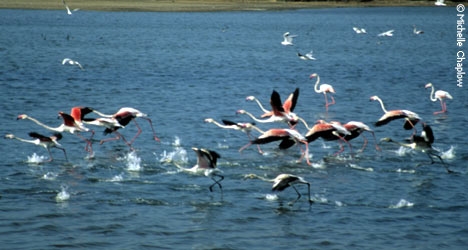 |
| Pink Flamingos in the Marismas del Odiel. |
Las Marismas del Odiel Natural Area
The Paraje Natural de las Marismas del Odiel is the second most significant wetland reserve in Andalucía after the Parque Nacional de Doñana. This large estuary and marshland of the Odiel and Tinto rivers covers 72-sq-km between Huelva City, Punta Umbría, Gibraleón and Aljaraque. It was granted protected status in 1989. The best time to visit is in spring during the breeding season and in winter when there are lots of waterfowl.
Within the Odiel nature reserve are some smaller protected areas: the Reserva Natural Marismas del Burro between Gibraleón and Huelva city; the Reserva Natural Isla de Enmedio between Aljaraque and Punta Umbría; the Paraje Natural Estero de Domingo Rubio south of La Rábida; and the Paraje Natural Lagunas de Palos y las Madres between Huelva and Mazagón.
The Odiel nature reserve is also home to Huelva city's only beach, El Espigón. The beach is an isolated and tranquil beach located on the sand spit. Visit our Huelva City beaches page for more information.
Access
By far the best views of the marismas are along the causeway that crosses the marshes. To get there, follow signs out of Huelva city towards Punta Umbría. Cross the Río Odiel bridge and take the right fork for Ayamonte, then turn immediately left for Espigón. Instead of going on to the bridge again to return to Huelva, take the right turn - the Dique San Juan Carlos I road - which continues for about 20km through the centre of the Paraje. After 2km on the left is the visitor's centre, the Centro de Visitantes Calatilla.
La Calatilla Visitors’ Centre – Anastasio Senra
The 'Centro de Recepción La Calatilla – Anastasio Senra' visitor Centre has been open since 1994. It offers basic information on the different aspects of this natural area, to those who are interested. The Centre is also home to the offices that take care of the area and its natural habitat. The Centre has a very interesting exhibition with information boards, tools, samples of vegetation and animal life, archeological remains and audiovisual information on the salt marshes. Visitors to the Centre can obtain information on guided tours, etc. There is a large car park and this makes a good starting point for some of the signed footpaths. It is located on the Dique San Juan Carlos I road. and overlook the River Odiel. There is a popular restaurant located next to the visitors centre.
Visitors center Opening Times:
September-June, Tuesday-Sunday, 10:00-14:00hrs and 16:00-18:00hrs.
July and August, 10:00-14:00hrs and 18:00-20:00hrs.
Tel: 959 50 90 11
Suggested routes
Take the N-441 from Gibraleón to Huelva City and look out for the marismas on your right, which start a few kilomtres out of Gibraleón. Follow signs to Punta Umbría around the western edge of Huelva City, along a road that skirts the marismas. The A-497 Punta Umbría road goes over the Río Odiel bridge, which crosses the wetlands. The A-497 then goes over and around the marismas before reaching Punta Umbría.
The best route, however, is to take is the Dique San Juan Carlos I road, which runs for about 20km through the centre of the marismas. To get here, see Access.
Flora and fauna
The marismas are renowned for their rich flora and fauna and are an important stopping place for migratory birds. A third of Europe's spoonbill population lives here and in winter there are many aquatic birds here.
The varied habitats range from salt and freshwater marshes, salt pans to intertidal islands, lagoons and creeks. These support a wealth of birdlife, the most important being between 300 and 400 pairs of spoonbills, along with grey and purple herons, flamingoes, storks, marsh harriers, little egrets, little terns, black-winged stilts, Kentish plovers, cormorants and ospreys. During migration and in winter you can see often thousands of flamingoes and waders. There is also a wide variety of gulls.
There is an incredibly rich variety of vegetation in the marismas, including tamarisk, rosemary, glasswort, junipers and stone pines. On the dunes are white retama, thyme and sea lavender. In spring the marismas are smothered in blue and yellow salt marsh flowers.
Rivers
The main river running into the nature reserver is the Odiel, which turns into an estuary riddled with creeks, particularly at its northern end. The other rivers within the area are Río Aljaraque, Río de la Bota and Río Punta Umbría.
Walks
There are several footpaths across the marismas with birdwatching sites starting from near the vistors' centre, the Centro de Visitantes Calatilla. Alternatively, there are is a signposted walk along the cycleway from the campsite at Playa La Bota, which covers 5.5km and takes around 3 hours. This follows the shores of the Bota and Punta Umbría rivers and passes a former saltworks, before entering Punta Umbría at its northern end.
You can also walk from Gibraleón train station along the vía verde, a disused railway line converted into a cycleway and footpath that runs to all the way to Ayamonte, passing through the northern protected corner of the marshland. It crosses the Odiel river just outside Gibraleón.
Nearnby cities and towns
Huelva
Punta Umbría
More Information
The Centro de Visitantes Calatilla (see above).
The tourist offices in Huelva City and Punta Umbría also have information.